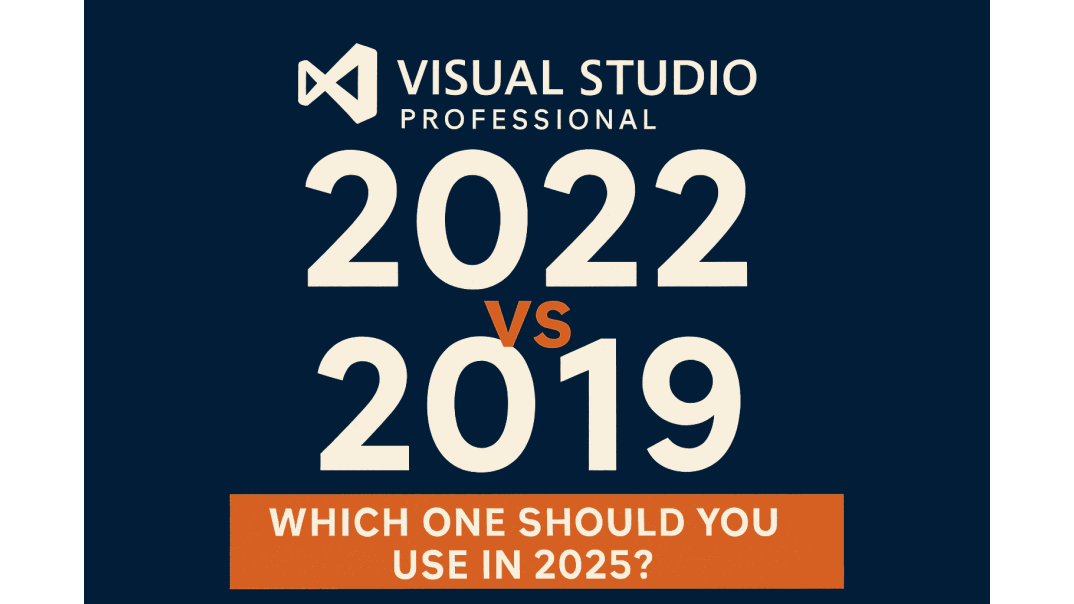Visual Studio Professional has long been the go-to integrated development environment (IDE) for developers working across the Microsoft stack. Whether you're building enterprise web apps, desktop software, or cross-platform tools, Visual Studio delivers the power and flexibility dev teams need.
However, even in 2025, the debate continues: Visual Studio Professional 2022 vs. 2019: which version is the better choice today?
This article cuts through the noise with a straightforward comparison of Visual Studio 2019 and 2022, helping you choose the edition that best fits your current and future development needs.
Quick Overview of Visual Studio Professional 2019 and 2022
Before we dive into the features, let’s quickly recap the history of each version and who’s still using them today.
Release Timeline
- Visual Studio 2019 was released in April 2019, built for .NET Framework and early .NET Core workloads.
- Visual Studio 2022 was launched in November 2021 and marked a significant shift with its move to a 64-bit architecture and focus on .NET 6 and beyond.
Who’s Using What?
- Visual Studio 2019 remains popular among teams supporting legacy applications or using older frameworks.
- Visual Studio 2022 is widely adopted by modern dev teams building for .NET 6/7 and working on large-scale, resource-intensive projects.
Why This Decision Still Matters
Choosing between the two isn’t just about having the latest features. It impacts:
- Framework compatibility
- Application performance
- Development workflows
- Long-term support and security
- Cost and system requirements
Let’s break down the differences in detail.
Key Differences Between Visual Studio 2019 and 2022
Architecture & Performance
- VS 2022 is the first 64-bit version of Visual Studio, allowing it to use more memory and handle larger solutions without performance degradation.
- VS 2019 is 32-bit, which can bottleneck performance for massive enterprise codebases.
IntelliCode and AI Features
- VS 2022 offers an upgraded IntelliCode, with better AI-based code suggestions and context-aware completion.
- VS 2019 also has IntelliCode, but it’s less refined and doesn't support as many scenarios.
UI and Accessibility
- VS 2022 introduces a modernized UI, high-DPI support, and enhanced accessibility features, particularly for developers with visual or mobility impairments.
- VS 2019 retains a traditional layout, which some developers still prefer for its familiarity.
Language and Platform Support
- VS 2022 supports the latest standards like C# 10, .NET 6 and 7, and MAUI.
- VS 2019 maxes out at .NET 5 and doesn’t support newer C# or platform improvements.
Debugging and Diagnostic Tools
- VS 2022 delivers faster load times, better Git integration, and smarter diagnostics.
- VS 2019 includes solid debugging tools but lacks the enhanced live previews, memory diagnostics, and profiling improvements introduced in 2022.
Side-by-Side Comparison: Visual Studio 2022 vs 2019
| Feature | Visual Studio 2019 | Visual Studio 2022 |
|---|---|---|
| Architecture | 32-bit | 64-bit |
| .NET Support | Up to .NET 5 | .NET 6, .NET 7, MAUI |
| IntelliCode | Basic AI suggestions | Advanced AI, context-aware |
| UI & Accessibility | Classic layout | Modern design, high-DPI, accessibility |
| Performance | Good for small/medium projects | Excellent for large solutions |
| Debugging Tools | Standard | Enhanced diagnostics & live analysis |
| Git Integration | Basic | Deep GitHub integration |
| Best For | Legacy app maintenance | Modern app development |
Benefits of Upgrading to Visual Studio 2022
If you're still considering whether to upgrade, here are the key reasons Visual Studio 2022 is worth it:
1. Performance and Scalability
The 64-bit architecture means faster response times, fewer crashes, and better memory usage, especially when working with massive enterprise codebases.
2. Smarter IntelliSense and Live Code Analysis
VS 2022's upgraded IntelliCode and real-time code analysis significantly boost productivity by flagging issues and offering suggestions as you type.
3. Support for Modern Frameworks
If you're building with .NET 6, .NET 7, or experimenting with MAUI for cross-platform apps, VS 2022 is a must.
4. Longer Support Lifecycle
Microsoft will continue supporting Visual Studio 2022 well beyond the expected end of mainstream support for 2019. This makes VS 2022 the future-proof option for teams planning long-term projects.
5. Better Collaboration Tools
With built-in GitHub integration, pull request reviews, and live sharing, VS 2022 enables faster team collaboration and CI/CD workflows.
Why Some Developers Still Use Visual Studio 2019
Despite its older architecture, Visual Studio 2019 still holds value for many dev teams in 2025.
Stability for Legacy Applications
Some mission-critical applications still run on older .NET Frameworks, and VS 2019 remains compatible with these environments.
Compatibility with Legacy Toolchains
VS 2019 works seamlessly with older third-party tools, plugins, and extensions that may not have been updated for 2022.
Lower Hardware Requirements
For teams running on older machines, the lighter resource footprint of VS 2019 can be a practical choice.
Familiarity for Existing Teams
Some developers prefer the classic UI and existing workflows, especially in organizations with slower tech adoption cycles.
Use Cases: Which Visual Studio Version Is Right for You?
Choosing between Visual Studio Professional 2022 vs 2019 depends on your use case:
Use Visual Studio 2022 If You:
- Develop modern apps using .NET 6 or 7
- Handle large, complex solutions
- Need enhanced IntelliCode, debugging, and collaboration tools
- Want to future-proof your development environment
Ideal for: enterprise teams, DevOps-focused orgs, modern .NET developers, full-stack app builders.
Use Visual Studio 2019 If You:
- Maintain or support legacy applications
- Need compatibility with older frameworks or libraries
- Run development environments on older hardware
- Prefer a tried-and-tested IDE that’s still stable in 2025
Ideal for: IT support teams, internal tooling developers, academic environments, freelancers maintaining old codebases.
Visual Studio Professional Licensing with Brytesoft
Regardless of which version you choose, obtaining it through a trusted Microsoft partner is crucial for licensing. At Brytesoft, we offer:
- 100% genuine product keys for Visual Studio Professional 2019 and 2022
- Significant cost savings compared to retail
- Expert support from a knowledgeable team
- Instant delivery and easy setup for your development environment
👉 Explore our offerings:
Whether you're upgrading or sticking with a legacy system, we make access affordable and straightforward.
Final Thoughts: Should You Upgrade Visual Studio?
Here’s the short version:
- Visual Studio 2022 offers better performance, scalability, and modern features.
- Visual Studio 2019 delivers stability, legacy support, and lighter requirements.
Your decision should depend on your current tech stack, hardware, team size, and future development goals.
If you're building for the future, upgrade to Visual Studio 2022. If you're maintaining the past, stick with Visual Studio 2019, and revisit your options when your next major project begins.
🔗 Ready to get started? Shop Visual Studio Professional keys from Brytesoft and take the next step with confidence.
FAQ About Visual Studio Professional 2022 vs 2019: Which One Should You Use in 2025?
Is Visual Studio 2019 still supported by Microsoft in 2025?
Yes, but support is limited. As of 2025, Visual Studio 2019 is in its extended support phase, which means it will only receive critical bug fixes and security patches, but not new features. For full-featured development and modern framework support, upgrading to Visual Studio 2022 is recommended.
Can I run Visual Studio 2022 on the same machine as Visual Studio 2019?
Yes, you can install both side by side. Visual Studio 2022 and 2019 are designed to coexist without conflict. This is useful if you're maintaining legacy projects in 2019 while starting new development in 2022. Ensure your system meets the hardware requirements for both.
Will my existing Visual Studio 2019 projects work in Visual Studio 2022?
In most cases, yes. Visual Studio 2022 supports backward compatibility for most project types. However, some older SDKs, extensions, or third-party dependencies may need updates. It's recommended to back up your project before upgrading and test it in VS 2022 before committing to a full migration.
Is there a learning curve when switching from VS 2019 to 2022?
Minimal, but noticeable. The core UI and workflows are similar, so you won’t need to relearn the IDE. However, Visual Studio 2022 introduces new features, such as smarter IntelliCode, Git integration, and performance diagnostics, that may take some time to explore and adopt fully.
Do I need new hardware to run Visual Studio 2022 effectively?
This may be the case, depending on your current system. Visual Studio 2022 is a 64-bit application and is optimized for systems with more RAM and modern processors. While it may install on older machines, to fully benefit from its performance improvements, a more powerful setup is recommended. Check system requirements on Visual Studio 2022 Professional at Brytesoft.




